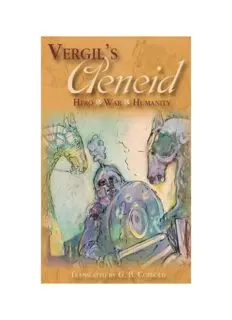
Vergil's Aeneid: Hero War Humanity PDF
Preview Vergil's Aeneid: Hero War Humanity
Translated by G. B. Cobbold Bolchazy-Carducci Publishers, Inc. Wauconda, Illinois USA Editor Laurie Haight Keenan Contributing Editor L. Dale Griffi th Cover Design & Typography Adam Phillip Velez Margaret W. Pearce Cover & Other Illustrations © Thom Kapheim All rights reserved Vergil’s Aeneid Hero • War • Humanity Translated by G. B. Cobbold © 2005 Bolchazy-Carducci Publishers, Inc. All rights reserved. Bolchazy-Carducci Publishers, Inc. 1000 Brown Street Wauconda, IL 60084 USA www.bolchazy.com Printed in the United States of America 2006 by United Graphics ISBN-13: 978-0-86516-596-0 ISBN-10: 0-86516-596-3 ———————————————————————————————————— Library of Congress Cataloging-in-Publication Data Virgil. [Aeneis. English] Vergil’s Aeneid : hero, war, humanity / G.B. Cobbold, translator. p. cm. Summary: “A prose translation of Vergil’s Aeneid with new illustrations and informational appendices”--Provided by publisher. Includes bibliographical references and index. ISBN 0-86516-596-3 (pbk. : alk. paper) 1. Epic poetry, Latin--Translations into English. 2. Aeneas (Legendary character) 3. Legends--Rome. I. Cobbold, G. B. II. Title. PA6807.A5C57 2005 873’.01--dc22 2005004513 F D OR IANA (cid:1) (cid:1) C ONTENTS Notes on the Translation ix The Life of Vergil xvii Map of Aeneas’ Voyage xviii Book I: A Shipwreck and a Rescue 1 Book II: The Wooden Horse 31 Book III: Monsters, Omens and Signs 59 Book IV: An Impossible Passion 87 Book V: Funeral Games and Burning Ships 113 Book VI: The Golden Bough: Aeneas in the Underworld 143 Book VII: The Gates of War 173 Book VIII: New Allies and New Armor 199 Book IX: Death in the Dark 225 Book X: Fathers and Sons 251 Book XI: The Latins’ Last Stand: A Woman Warrior 281 Book XII: Decision and Revenge 309 Appendix I: Outline of the Plot of the Aeneid 339 Appendix II: Signifi cant Events in Roman History 343 Appendix III: Family Trees 345 Appendix IV: Discussion Questions 349 Appendix V: The Main Characters of the Aeneid 353 V (cid:1) (cid:1) A CKNOWLEDGMENTS I am extremely grateful to Stephanie Quinn, who, during the early drafts of this translation, off ered crucial comments and advice, and to Dale Griffi th, who spotted ambiguities with an eagle eye for detail and made many rough places smooth. Adam Velez’ design of the completed work is both ingenious and elegant, and certainly contributes to the overarching vi- sion of Lou and Marie Bolchazy, that the ancient classics must and can be made accessible to a wider world than the schol- ars’ dusty libraries. But above all I would like to thank Laurie Haight Keenan, who with inexhaustible patience and good hu- mor guided the whole work ab ovo usque ad malum. VII (cid:1) (cid:1) N T OTES ON THE RANSLATION Everybody takes for granted that, in an ideal world, it would be preferable to read a work of literature in the original language rather than in a translation. No translation can imitate the pe- culiar music of the “out of” language, and so some aesthetic or emotional eff ect must be lost in any “into” version. The Ae- neid is, of course, no exception: regardless of their meaning, the words and phrases of Vergil’s Latin do not sound like Eng- lish, and Latin sentences are not put together in the same way as English; they cannot therefore strike the ear or the heart in exactly the same way. The subtleties of Latin allow eff ects and emphases unachievable in English; and such devices as alliteration or assonance or onomatopoeia can at best be only approximately reproduced. Moreover, the rhythms of the Ae- neid’s verse are characteristically Latin, even though its meter is the same dactylic hexameter* that Vergil’s model Homer had used in Greek. Vergil uses the hexameter (which is unfi tted to English) both because it comfortably fi ts the natural rhythms of Latin speech, and because its fl exibility allows him to echo any variation of pace and mood in the progress of his narra- tive. And he uses it inimitably: Tennyson said that, as Vergil wrote it, it was “the stateliest measure ever moulded by the hand of man.” * Six metrical feet: each of the fi rst four can be either a spondee (two long syllables) or a dactyl (one long syllable followed by two short). The fi fth foot is always a dactyl, the last a spondee. IX
